In August 1939, the Surrealist artist Wolfgang Paalen visited Emily Carr in her Victoria home. In September, Carr wrote to a colleague, “I had an interesting French Artist to see me this summer.”
Rapport between her, then 67, grouchy, insecure and in poor health, and Paalen, half her age, not French, exactly, but a Paris-based Austrian, arriving on her doorstep after a momentous journey from Alaska to southern British Columbia, would have seemed unlikely. Carr deplored Surrealism, regarding it as the product of “diseased minds…skipping over sanity and decency.”
Yet it appears that Carr was delighted by Paalen, who had joined the Surrealist movement in 1935 at the invitation of André Breton and participated in important related exhibitions in Paris, New York and London.
During that 1939 visit to Carr’s little house, Paalen might have connected with her through the accounts of his travels to many of the same Indigenous Northwest Coast sites that Carr had visited in 1908, 1912 and 1928. He also admired Carr’s “Indian” paintings, an undoubtedly gratifying experience for the Victoria artist, isolated as she was from the cultural life of the great cities—and confronted daily, in her cramped studio, with racks of unsold canvases.
These unsold canvases would become the Emily Carr Trust, the foundation of the Vancouver Art Gallery’s famed collection of her works. These unsold canvases, too, Carr would have pulled out to show Paalen and his two travelling companions: his wife, poet Alice Rachon, and his wealthy photographer friend and patron, Eva Sulker.
Although the viewer can’t help but wonder about the Paalen trio’s ménage, the thoughtfully conceived and elegantly executed exhibition “I Had an Interesting French Artist to See Me This Summer: Emily Carr and Wolfgang Paalen in British Columbia,” currently on at the Vancouver Art Gallery, doesn’t dwell upon that. It focuses primarily on paintings and drawings by Paalen and Carr—though some of Sulzer’s black and white photos, of Northwest Coast First Nations villages and monumental carvings, and a reproduction of a Rachon painting of Kispiox, in an issue of Paalen’s magazine Dyn, are included in the support material.
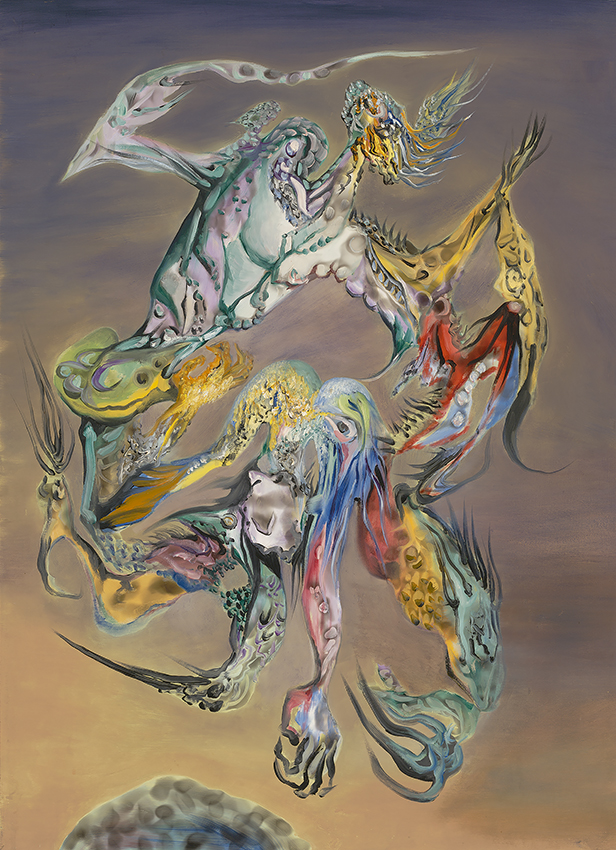 Wolfgang Paalen, Combat des princes saturniens III, 1939. Fumage, oil on canvas. Collection of Andrew S. Teufel, San Francisco. Photo: Courtesy of Gallery Wendi Norris.
Wolfgang Paalen, Combat des princes saturniens III, 1939. Fumage, oil on canvas. Collection of Andrew S. Teufel, San Francisco. Photo: Courtesy of Gallery Wendi Norris.
Guest-curated by poet, essayist and filmmaker Colin Browne, “I Had an Interesting French Artist to See Me This Summer” explores thematic and philosophical parallels between Carr and Paalen. It suggests that, ultimately, both were compelled by a desire to express, through their art, a kind of transcendent condition or a cosmic energy, treating the natural world, in Carr’s case, or Indigenous art, in Paalen’s, as a conduit to that condition, that energy.
Carr’s creative aspirations were profoundly shaped by an animistic form of Christianity, by her belief that God dwelt in every leaf, branch, and blade of grass within her beloved West Coast rainforest. Paalen’s philosophy is a little more difficult to grasp, attaching itself to science rather than religion, but at the same time, finding a transformational expression within the First Nations Art he encountered.
In the exhibition catalogue, Browne writes, “the monumental and ceremonial works of the Northwest coast were, for Paalen, surging with a life force vital to the creation of a new humanity.” In Indigenous art, he saw “the universal interconnectedness of all things and the pulse of perpetual transformation.”
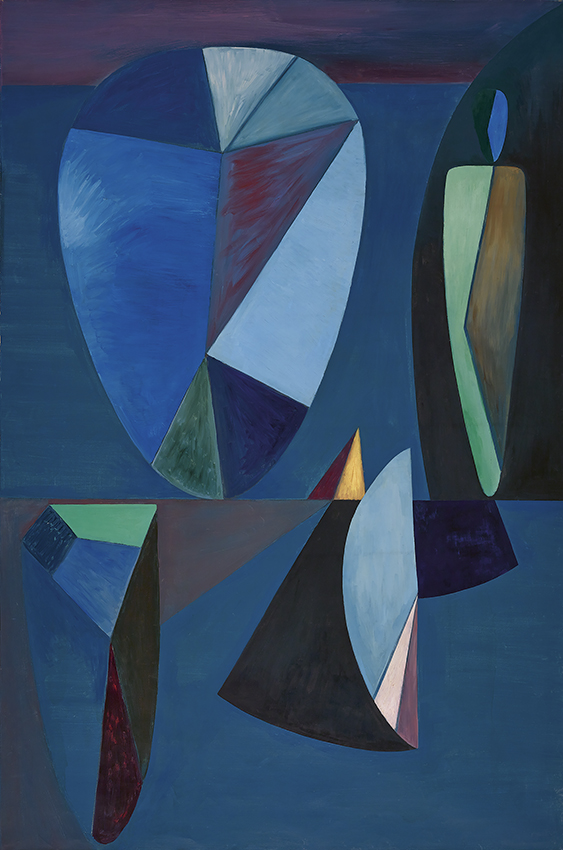 Wolfgang Paalen, La roue de l’orage, 1935. Oil, tempera on canvas. Collection of Lucid Art Foundation. Photo: Courtesy of Gallery Wendi Norris.
Wolfgang Paalen, La roue de l’orage, 1935. Oil, tempera on canvas. Collection of Lucid Art Foundation. Photo: Courtesy of Gallery Wendi Norris.
“I Had An Interesting French Artist To See Me This Summer” is rooted in two important curatorial initiatives at the Vancouver Art Gallery.
The first is the ongoing series of shows in which selections from the gallery’s collection of Carr paintings and drawings are freshly reconsidered by placing them in dialogue with the works of other artists and art movements, past and present.
The second is the VAG’s 2011 Surrealist exhibition, “The Colour of My Dreams,” curated by the British scholar Dawn Ades. A wide and richly various survey of the movement, it also included examples of the Northwest Coast First Nations art that the European Surrealists found so appealing.
In addition to his beautifully written catalogue essay for the Carr-Paalen show, Browne contributed an essay to the substantial “Colour of My Dreams” publication and has deeply researched the subject of the Surrealists’ particular interest in Northwest Coast visual culture for a forthcoming book. He is superbly qualified to illuminate the ways in which Paalen was influenced by the Indigenous art he saw and collected on his 1939 journey, and he has done an impressive job of gathering Paalen’s paintings from an international array of private and public collections.
As well, Browne has unearthed a lode of archival materials related to the Carr-Paalen–Northwest Coast nexus and has seeded the show with quotes from both artists.
Carr’s remarks about her creative aspirations and her deep connection with her subjects are familiar yet still illuminating; Paalen’s quotes, expressing his later philosophical beliefs (after he left the Surrealist movement) are more arcane, at least as delivered here. He apparently sought to reconcile his approach to abstraction with quantum theory and also with strange notions of ancestral beings existing alongside us through time and space.
In one instance, Paalen demands, “Why should works of art be easy to understand in a world in which nothing is easy to understand?” Browne writes that “Paalen was profoundly alone in developing a complex private myth of ancestral figures and attempting to generate through his paintings the experience of being inseparable from timeless, limitless space.”
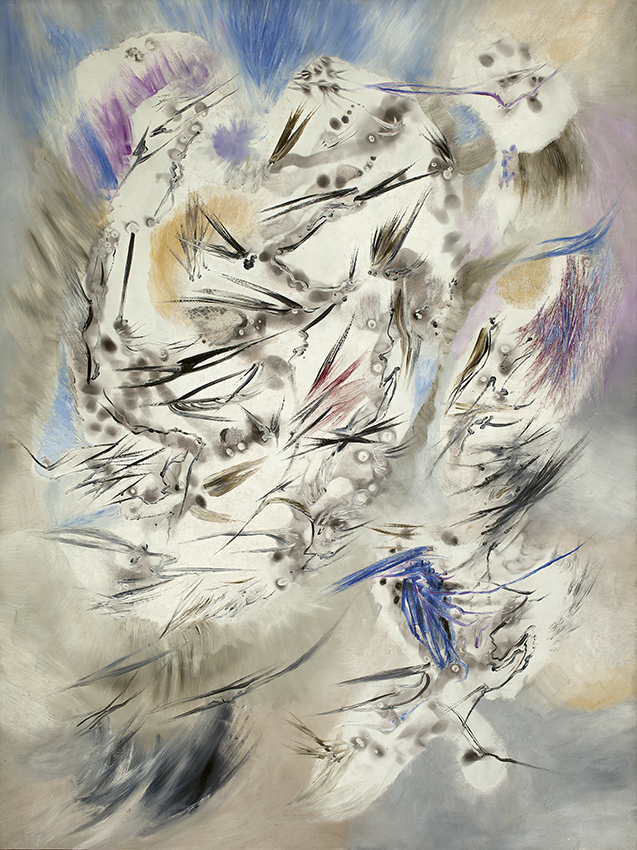 Wolfgang Paalen, Bella Coola, 1939. Oil on canvas. Collection Andrés Blaisten.
Wolfgang Paalen, Bella Coola, 1939. Oil on canvas. Collection Andrés Blaisten.
The show opens with Carr’s post-Impressionist paintings of First Nations subjects, Kwakiutl House, Skidegate and Indian Raven, Yan. All were created in 1912 following her studies in France, probably exhibited in Vancouver in 1913, then put away, in discouragement, until her inclusion in the 1927 breakthrough exhibition at the National Gallery, “Canadian West Coast Art: Native and Modern.” That show, of course, introduced her to the Group of Seven, validated her through a wider and more appreciative audience, and ushered her into a period of vigorously renewed creativity.
Lawren Harris’s influence is evident in a number of Carr’s later-period works, such as Old Time Coast Village (1929–30), with its ghostly white dwellings and denuded poles, backed by a massive, sculptural curtain of dark green rainforest. In the exhibition, it is met by Paalen’s Surrealist paintings of the 1930s, including La roue de l’orage (The Wheel of the Storm) (1935) with its geometricized rendering of forms in murky space and its mask-like allusions to Cycladic art, and Les tours de lumière (Towers of Light) (1936), with its “totemic” forms hovering above a rocky and desolate landscape. A bird-like figure in this mysterious grouping appears to anticipate the monumental sculptures Paalen would later encounter on the Northwest Coast and speaks, too, to the crest figures of Eagle and Raven atop the poles Carr depicted.
Paalen’s marriage of veristic and biomorphic Surrealism is highly reminiscent, perhaps derivative, of Yves Tanguy, although Paalen’s paintings are characterized by an increasingly dark mood of dread and foreboding. As the show tells us, his father’s Jewish background would have magnified his fears of Hitler’s rise to power and the malignant swell of anti-Semitism and bellicosity in Europe.
These conditions are expressed in particularly sinister terms in Orages magnetiques (Magnetic Storms) (1938) and Combat des princes saturniens III (Combat of the Saturnian Princes III) (1939) with their clawed and tangled symbols of death, devastation and demonic evil.
The nearby placement of Carr’s Vanquished (1930) its line of tilting mortuary poles fronting an abandoned Haida village, seems to pose a record of an already decimated people against the anticipation of another kind of holocaust.
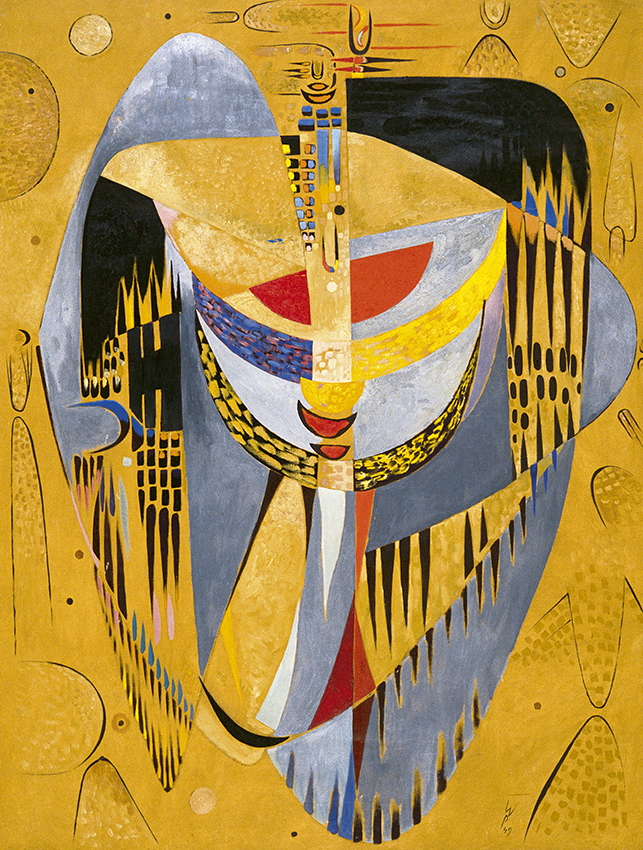
Wolfgang Paalen, Messagers des trois pôles, 1949. Oil on canvas. Collection of Lucid Art Foundation.
When Carr first undertook to depict Indigenous Northwest Coast poles in situ, her intention was documentary. As she enlarged her formal understanding of contemporary Western art, her depictions of monumental First Nations art were not so much records of what she believed to be a vanishing culture as they were vehicles for her own creative expression.
After Harris persuaded Carr to give up First Nations subjects and focus on landscape, the coastal rainforest became that expressive vehicle. It also enabled her to more fully realize her spiritual beliefs, imposing them more compatibly on the landscape rather than on a separate and distinct material culture she scarecely understood. Her paintings of soaring evergreens, of old growth and new, and of wide open skies above tracts of logged-over and torn-up land, make ecstatic use of rhythmic concentricites.
Through repetitive and pulsing lines and forms, as seen in Juice of Life (1938–39) and Above the Gravel Pit (1937) Carr unconsciously aligns her art with the mystical and the transcendental (and, more obviously, with the paintings of Vincent van Gogh).
In the early 1940s, after he had settled in Mexico, Paalen also began to paint and draw concentric lines and forms—in some cases, such as an untitled 1941 drawing, using hatched lines, circles and parabolas to signify a kind of universal energy. (The parabola was an especially important form for him.)
As well, he pursued a number of rhythmic variations on a small, crouching figure in stone—an ancient, First Nations object of uncertain origin, which he acquired in Bella Coola. His attachment to and inspiration from this figure is consonant with the Surrealists’ belief that, in Indigenous art, “the sacred, the aesthetic and the practical were united by a single generative impulse.”
Again, Browne writes that Carr and Paalen both “opened themselves to the pulsing rhythms of cosmic energy that coursed through all inert and living things: Carr’s trees, swaying and trembling with the spirit of God; Paalen’s little stone ancestral figure, in a state of flux and metamorphosis.”
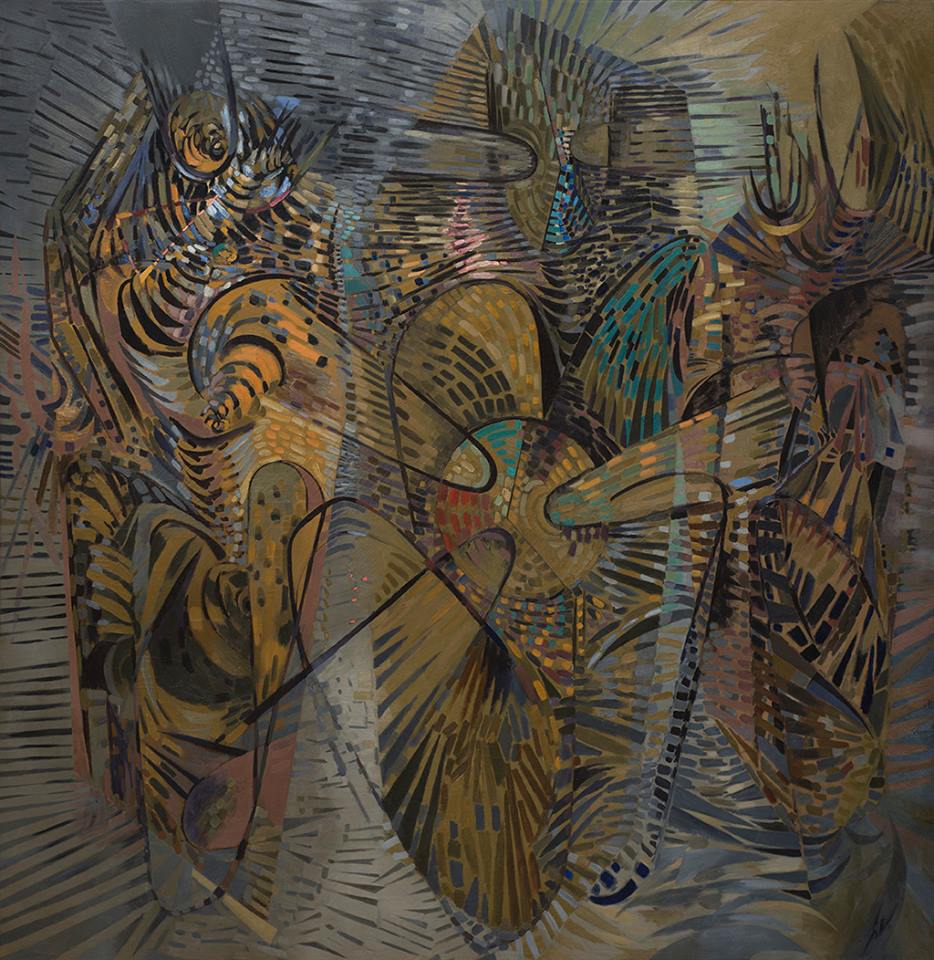 Wolfgang Paalen, Les cosmogonies, 1944. Oil on canvas. Collection of Rowland Weinstein. Courtesy of Weinstein Gallery. Photo: via Vancouver Art Gallery Facebook page.
Wolfgang Paalen, Les cosmogonies, 1944. Oil on canvas. Collection of Rowland Weinstein. Courtesy of Weinstein Gallery. Photo: via Vancouver Art Gallery Facebook page.
After severing his ties with Surrealism and its dedication to tapping interior realities and the unfettered impulses of the unconscious mind, it seems that Paalen sought to expand consciousness outward, toward something vast and universal, in accord with his interpretation of quantum theory.
The climax of the show is provided by four big, luminous abstractions by Paalen, including Nuit tropicale (Tropical Night) (1948) and Messengers from Three Poles (1949). We’re told he eschewed the spiritual, seeking a cosmological understanding through science rather than religion, and yet, among the curving forms and mosaic-like paint application that characterize these later abstractions, there is the persistent suggestion of large, hovering, sometimes winged beings, of ancestors, angels or archetypes in configurations of three.
In repudiating Surrealism, Paalen also disavowed representation, and is credited with setting the stage for the New York abstractionists. Yet somehow, at least in the late works on view here, he could not relinquish depicting those mysterious, spectral figures.
When Carr depicted three tall trees in a clearing, as in an untitled landscape of 1938–39, the trinity was certainly Christian.
It appears Paalen would have refuted any such interpretation to his groups of three, but it is possible that the pervasive symbolism of Christianity had imprinted itself on his unconscious.
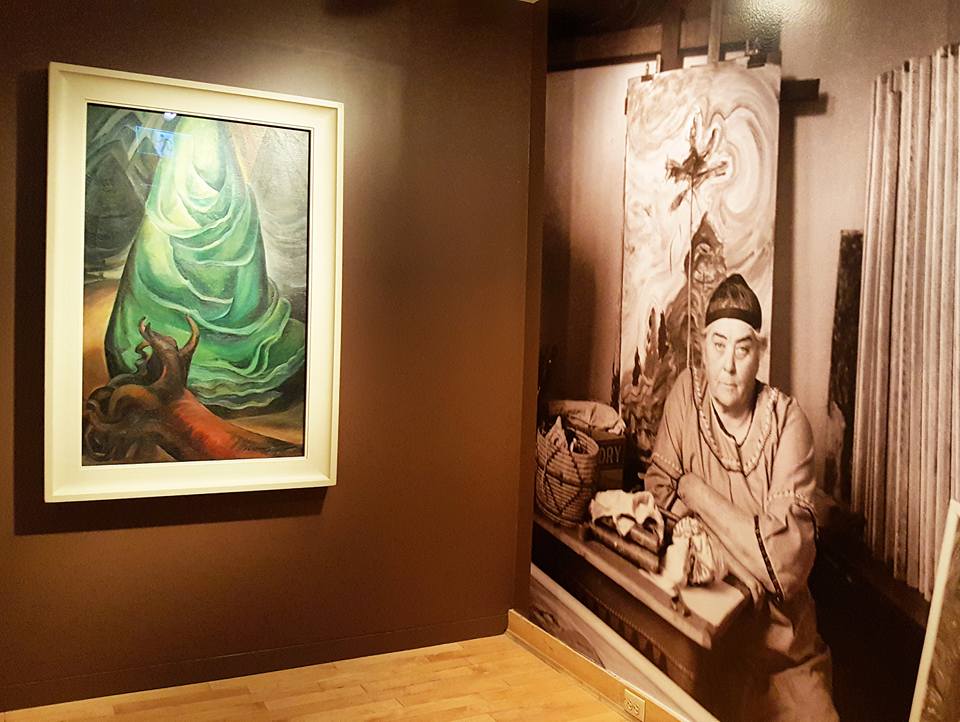 An archival image of Emily Carr installed alongside one of her paintings at the Vancouver Art Gallery. Photo: via Vancouver Art Gallery Facebook page.
An archival image of Emily Carr installed alongside one of her paintings at the Vancouver Art Gallery. Photo: via Vancouver Art Gallery Facebook page.
Although this exhibition draws many productive formal and thematic parallels between Carr and Paalen on formal and thematic terms, thornier issues also rise to the surface.
What these unlikely contemporaries shared, beyond their creative struggles to express their transcendent visions, was Modernism’s need to compel the art of the colonized Other to conform to its beliefs—whether that had to do with the white settler’s conviction that First Nations art and culture were disappearing (Carr) or a sense of the inter-relatedness of all things and the inter-penetration of multiple planes of existence (Paalen).
With the Surrealists, there was a deep disenchantment with the “civilized” West and a longing to identify with alternative cultures and spiritual values, and a conviction that Indigenous artworks could serve as “luminous guides for a world that would have to renew itself…”.
With Carr, there was the personal sense of alienation, of being an outsider and therefore the desire to identify herself with a marginalized people.
In a subtextual way, this exhibition forces contemporary viewers to confront our post-modernist distaste for the appropriation and misreading of the cultural expressions of others.
In this apocalyptically over-heated, over-polluted and over-populated age, we are also inclined to disparage the romantic conviction that there is no disaster—no clearcut, no open-pit mine, no disease-ravaged village—that nature cannot heal, that nature cannot transcend.
We’ve become jaded. Angels—whether in the form of trees, rocks, or looming ancestral figures—no longer dwell among us.
“I Had An Interesting French Artist To See Me This Summer: Emily Carr and Wolfgang Paalen in British Columbia” is at the Vancouver Art Gallery until November 13.
Robin Laurence, who recently received the 2016 Royal Canadian Academy of Arts medal, is an independent writer and curator based in Vancouver. She is the award-winning visual arts critic for the Georgia Straight and has contributed many hundreds of features, reviews and essays to local, national and international publications.

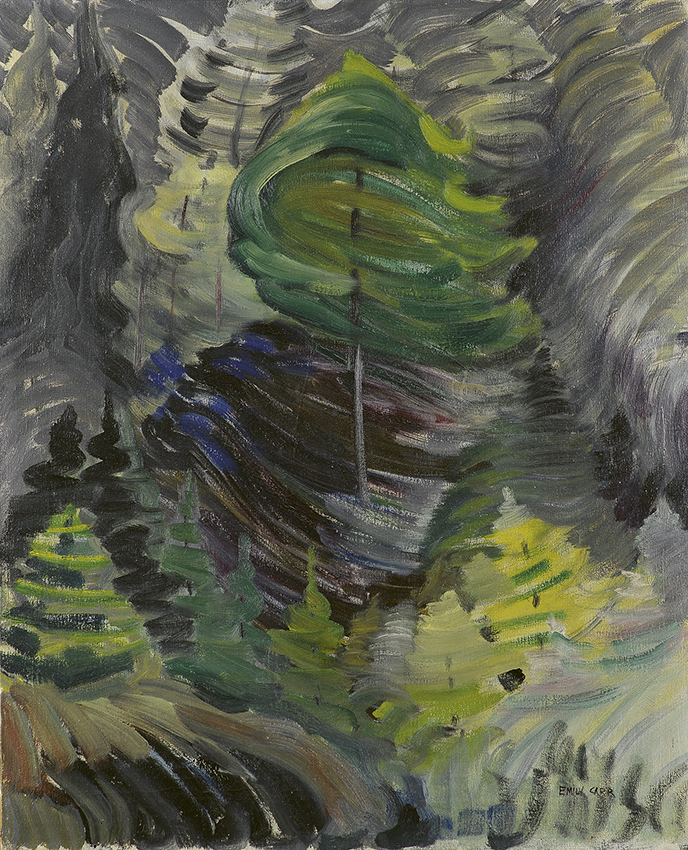 Emily Carr, Juice of Life, 1938–39. Oil on canvas. Collection of the Art Gallery of Greater Victoria, Gift of Dr. Ethlyn Trapp, Vancouver. Photo: Stephen Topfer, Art Gallery of Greater Victoria.
Emily Carr, Juice of Life, 1938–39. Oil on canvas. Collection of the Art Gallery of Greater Victoria, Gift of Dr. Ethlyn Trapp, Vancouver. Photo: Stephen Topfer, Art Gallery of Greater Victoria.







